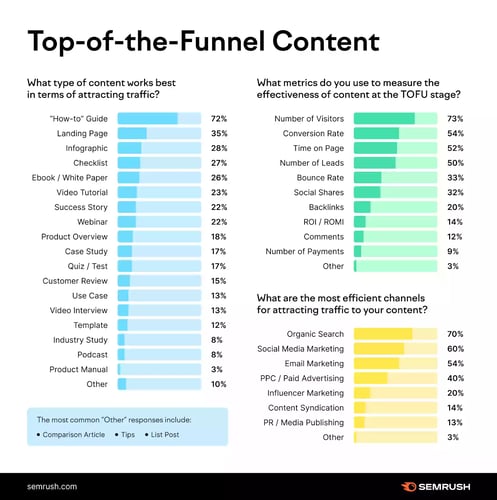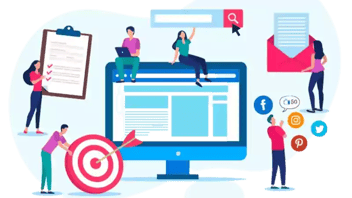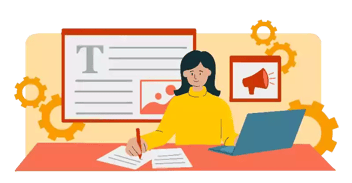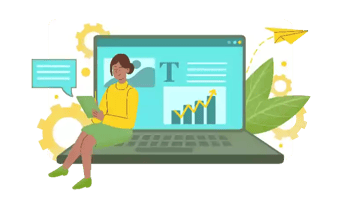Elevate your content with HubSpot Marketing Hub for content marketing. Discover how our strategies and HubSpot's tools drive success.
What Is the Content Marketing Funnel and Why Does it Matter?
The marketing and sales "funnel" has evolved into the "content marketing funnel" with unprecedented demand in the marketing world. This updated approach allows content marketers to align with sales processes by catering to each stage of the funnel with tailored content that assists in validating, nurturing, and converting leads into customers better and faster than before.

Why Does A Content Marketing Funnel Matter?
-
97% of B2B buyers use content to make purchase decisions. Effective content marketing is vital, especially for B2B companies. By crafting valuable content, businesses can captivate and entice potential buyers at every stage of the purchasing journey.
-
70% of marketers say content marketing positively impacts their business. Content marketing is an effective way to achieve business goals. Businesses can use content marketing to increase brand awareness, generate leads, and drive sales.
-
Content marketing costs 62% less than traditional marketing and generates 3x more leads. Content marketing is an effective way to reach your target audience with an attractive return on investment. Businesses can save money on marketing costs using content marketing instead of traditional marketing methods.
-
The average person spends 17 hours a week consuming content. Creating valuable content is a surefire way to reach a vast audience genuinely interested in what your business has to offer. With content marketing, you can captivate this audience and keep them engaged at every stage of their purchasing journey.
-
72% of consumers say they are likelier to do business with a company that provides helpful and relevant content. Creating valuable and relevant content can help businesses build customer trust and loyalty. By providing helpful content, businesses can show appreciation and establish a strong connection with their audience.
Traditional content marketing often creates content for the sake of content ("they say it attracts traffic") with little structure or methodology. "We have a Contact Us button that they can click on."
A well-constructed Content Marketing approach is not a race against the competition. It's more like a spectator sport where you watch your leads get closer. Each piece of content is an opportunity to bring a new lead closer to a sale or inspire an existing customer to take action. It is also a critical piece in creating and maintaining attraction.
Different stages in the funnel each get their own appropriately targeted content. This content attracts new customers and helps move them through the funnel from awareness to purchase to retention. Each piece of content has a job to do. What works to bring someone to your website will not necessarily motivate them to buy. You must create stage-appropriate content at each stage in a customer's movement through the content marketing funnel. Gone are the times, if they ever existed, when traditional content marketing created content with no purpose and hoped for a visitor to click the "Contact Us" button.
The Content Marketing Funnel
Most often stylized as a funnel, the content marketing funnel is a graphic that shows a system of stages (Awareness, Consideration, Decision Making, Delight), each with associated content. It starts with as many leads as possible and moves, or funnels, those leads through a step-by-step flow of content and converts them into actual customers.
At the top are many people who have become aware of your products or services. These are potential leads and future customers. Some will drop off as they move toward the narrower part of the funnel.
A smaller number will continue on the buyer's journey and become paying customers.
Awareness Stage (Top of the funnel)
This first stage of the content marketing funnel is where you want to attract and educate your audience on your topic, make them aware of you, and show them how you can solve their problems and eliminate their pain points.
At this stage, the content itself should not be about you. Here, you'll deliver exciting articles, updates, and posts that make potential customers want to engage with you.
Typical queries in this stage include terms like:
- Avoid
- Examples
- Find
- Guide
- Help
- How
- Ideas
- Improve
- Issue
- Learn
- Prevent
- Problem
- Show
- Solve
- Tips
That way, you can build relationships, entertain, educate, and speak to their passions—no hard sell.
The outcome you want from awareness content is website traffic. Once someone visits your website, they have entered your sales funnel. You can continue building brand awareness and moving them towards purchase by exposing them to your consideration-stage content. More on this is below.
You Might Also Like This Post:
The top-of-funnel content you create for the Awareness stage is most effective in these formats:
- Blog posts
- Ebooks
- Infographics
- Social media posts
- Videos
- Whitepapers
Note that not all audiences will react equally to the different forms of content, so mix it up. Study the available metrics to analyze which content performs best for your target audience. Look at total shares, views, time on page, scroll depth, and bounce rate.

Evaluation/Consideration Stage (Middle of the funnel)
At the Consideration stage, you build a relationship, create trust, and get your audience interested in your products. It's still not time for the hard sell, but once people know your brand, you want them to consider purchasing. Still, you don't want your content to read like an ad.
Typical queries in this stage include terms like:
- Advice
- Affordable
- Best
- Benefits
- Cheapest
- Compare
- Features
- Providers
- Pros and cons
- Risks
- Reviews
- Service
- Solution
- Software
- Tools
- Top
You want engaged readers to become customers by getting them thinking about your products. This stage is where potential buyers determine the legitimacy of your company, develop trust in you, and decide if they need your product.
That means creating:
- Blog posts
- Case studies
- Comparisons
- Newsletters
- Podcasts
- Reviews
- Webinars
- White papers
Guides, templates, and white papers influence leads and generate leads well. You can look at leads generated and influenced to determine which type of content performs the best.
Email marketing keeps your audience engaged and drives reliable website traffic while promoting your products. Still not the time for hard-sell tactics.
You want to measure views of your product/services/pricing page, demo or free trial requests.
Decision-Making Stage (Bottom of the funnel)
This is the stage where you seek to convert contacts that have expressed interest in your product into active customers. They know your brand and products, and it's time to make the sale.
Typical queries in this stage include terms like:
- Buy
- Cost
- Coupon
- Near me
- Policies
- Price/Pricing
- Purchase
- Return
- Sale
- Shipping
At this stage of the content marketing funnel, you are showing your audience that a purchase is their smartest next step. Your goal is to create bottom-of-funnel content that results in closing the deal. The most effective formats at this stage are:
- Readiness Assessments
- Calculators
- Case Studies
- Comparisons
- Implementation guides
- Product sheets
- Questionnaires
- Reviews
- Self-assessments
Bring on the (hard) sell.
Delight/Retention Stage
This is the crucial phase for retaining your customers in the long run. Here you continue to nurture customer relationships to retain the customers and increase their lifetime value to your business. Retaining customers is easier and less costly than winning new ones.
A good way to keep your customers engaged is an email newsletter they'll look forward to receiving. A bit of product promotion can be combined with great content that continues to educate and entertain them.
The goals of the delight stage content include renewal rates, increased product usage, online interactions, referrals, and user-generated content. Various content types that work at this stage include:
- Product guides
- Educational materials
- Member-exclusive content
- Forums
- Special offers
- Giveaways
Beyond the Marketing Funnel
To ensure your content is used to its maximum potential, you must deploy a well-constructed content marketing approach and align your content strategy and editorial calendar with your content marketing funnel. This gives you a clearer idea of your strategy, increases your content's efficacy, improves ROI, and aligns your content with the overall marketing strategy.
As a marketer, your goal is to nudge prospects down the funnel, keep them interested until they're ready to purchase, and then keep them returning for more.
This content is also available in:
- German: Was ist der Content-Marketing-Trichter und warum ist er wichtig?
- Spanish: ¿Qué es el embudo de marketing de contenidos y por qué es importante?
- French: L'entonnoir de contenu : c'est quoi et pourquoi c'est important?
- Italian: Cos'è l'imbuto del marketing dei contenuti e perché è importante?
- Chinese: 什么是内容营销漏斗以及为什么它很重要?












Leave a Comment